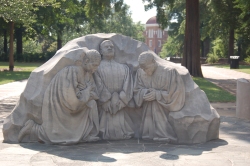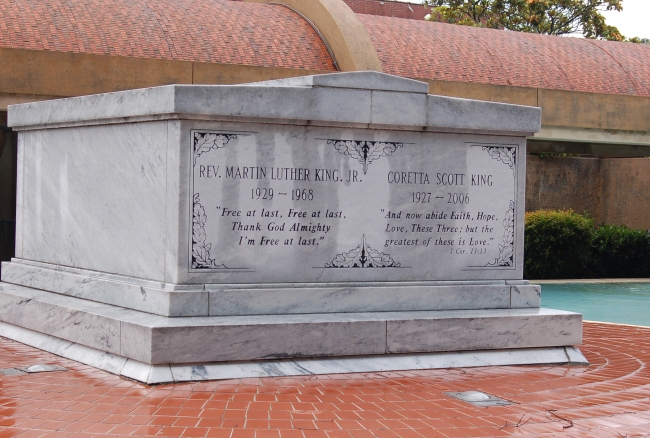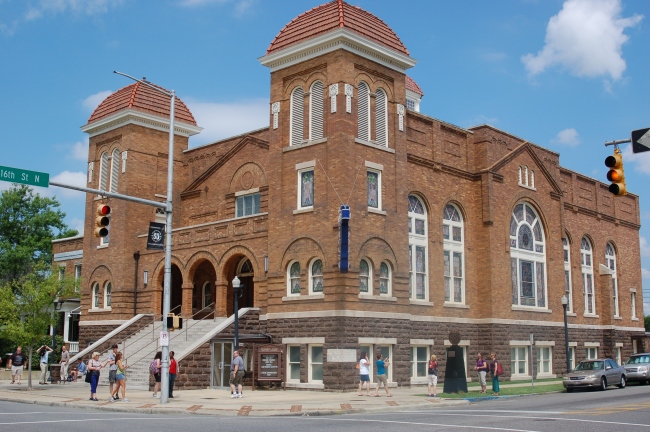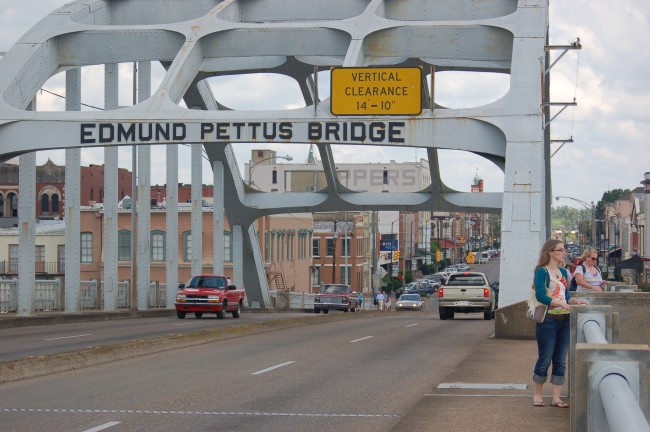From Richmond to Montgomery: Touring the Civil Rights South

It was an early Monday morning in June when two staff members from the Virginia Historical Society, a VCU history professor, and thirty-seven public school teachers from Chesterfield County prepared to fly from Richmond to Atlanta. We were all taking part in a federally funded Teaching American History grant program that would carry us through Georgia and Alabama to study the civil rights movement. Though Virginia is home to a lot of important civil rights history, the places we would be visiting on this trip were the ones you see in the history books and on documentaries like Eyes on the Prize.
After we landed in Atlanta, we took a bus to the Martin Luther King, Jr., National Historic Site on “Sweet” Auburn Avenue, where we toured a center dedicated to King’s life and philosophy of non-violence, as well as the home in which he grew up. We walked by Ebenezer Baptist Church, where King’s father had been the pastor, and continued to a long reflecting pool, where the Reverend and Mrs. King’s tomb stands, guarded by a nearby eternal flame. Using King as a prism for understanding the movement was a good way to begin our trip, but soon we would be learning of lesser-known local leaders and participants from the American civil rights story.
After traveling from Georgia to Alabama, our group arrived at a satellite campus of Auburn University in Montgomery, which served as the base from which we left each day to visit churches, museums, and other historic sites. Our first full day in Montgomery took us to Dexter Avenue Baptist Church where King served as pastor from 1954 to 1960. The church’s proximity to the Alabama state capitol, just a block away, provided a dramatic visual of a determined people who challenged ultimate state power. It was here, in the basement of this church, that King, Jo Ann Robinson, E. D. Nixon, and other activists established the Montgomery Improvement Association to direct the bus boycott after Rosa Park’s arrest in 1955.
Before King’s arrival, Dexter Avenue Baptist had been led by the Rev. Vernon Johns from Prince Edward County, Virginia, whose aggressive activism helped pave the way for King. It was Johns’s niece, Barbara Johns, who with guidance from her uncle, helped organize and lead students on strike for a better black high school in Farmville, Virginia. Their actions resulted in one of five legal cases from around the country that were combined in the 1954 Supreme Court case Brown v. Board of Education.
The following day found us in Birmingham, a southern city built on steel, which experienced some of the worst violence of the civil rights movement. Visiting the Sixteenth Street Baptist Church, with its beautiful brickwork, it was hard to imagine that sanctuary as the scene in which four young girls were killed by a Klansman’s bomb or Kelly Ingram Park, across the street, as the stage on which children, armed with songs, marched against police, who fought them with clubs, dogs, and water cannons. In front of the nearby Birmingham Civil Rights Institute stood a statue of the Rev. Fred Shuttlesworth, Birmingham’s fearless leader, who survived numerous beatings and terrorist bombings without losing his commitment to non-violent protest. Later, among the amazing exhibits inside the institute, I stood in front of the bars and a portion of the jail cell from which King wrote his “Letter From a Birmingham Jail” in 1963. Touring all this dark yet inspiring history provided a powerful reminder of the sacrifices people made in the past and an appreciation for the present they helped create.
Toward the end of the week, our travels took us through rural Alabama to the town of Selma, which still looks pretty much like it did in 1965. In that year, during protests for the right to vote, twenty-six-year-old Jimmie Lee Jackson was shot to death by police while interceding in the beating of his grandfather. His death led protestors to cross the Edmund Pettus Bridge above the Alabama River with the intention of marching to Montgomery. Instead they were met on the other side by mounted deputies and state troopers, who attacked with nightsticks and tear gas. Known as “Bloody Sunday,” the scene stunned viewers watching on television and led to King’s involvement in Selma’s struggles. Two weeks later he and several hundred protestors completed the march from Selma to Montgomery in what basically became a military operation with army troops and National Guardsmen providing protection. It was in the wake of these events that Congress passed the Voting Rights Act of 1965, which guaranteed all citizens the right to register and vote. A week after our visit, the U.S. Supreme Court struck down major provisions of the act.
While in Selma we met a man who shared stories about Jonathan Daniels, a white former VMI cadet, who had stayed with his family while living in Selma. Daniels was a dedicated activist and Episcopal seminarian who was shot to death by a deputy sheriff who was aiming his shotgun at a black teenage girl when Daniels pushed her out of the way. Later that day we saw a memorial to Viola Liuzzo, a Detroit woman who drove three days to Selma to help with the march. She was shot and killed by Klansmen during a high speed car chase.
Though Daniels and Liuzzo had both lost their lives, throughout the trip we were reminded that this was living history with participants who still speak and with issues that still resonate. The experience of walking where others had walked and hearing stories from history’s witnesses left us with a deeper understanding of events most of us had only read about. Standing in the kitchen of the Dexter Avenue Parsonage where the Rev. Dr. Martin Luther King, Jr., had a religious epiphany and overcame his fear of death, walking across the Edmund Pettus Bride, and standing by Virginia born Booker T. Washington’s grave at Tuskegee Institute were experiences one can’t receive from a book. By the time we returned to Virginia, I felt our tour had affirmed the value of historical tourism and the power of standing on the spot where the past took place.
Chris Van Tassell is the program coordinator for the Virginia Historical Society.



